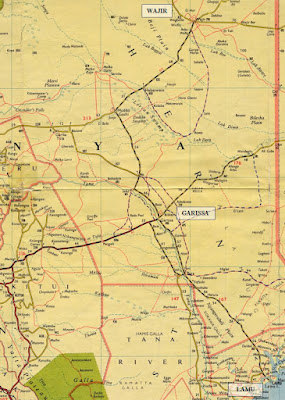
For a start, terrorism as you know has no border, no country, no religion, no nothing, Everyone's enemy is a terrorist.The Srilankan government calls freedom fighters, The Tamil, Terrorists.Nelson Mandela used to be called a terrorist and so on. Remember the IRA (Irish Republican Army)bombings of the 70's and 80's, Terror must never be tolerated.
Hulugho town, a remote Kenya-Somalia border town, neighbouring Garissa, has lately beenfacing a James Bond drama, teeming with soldiers, police and members of the Anti-Terrorism Police Unit (ATPU) looking for one Fazul, alledged to be the principal target of a US raid on Ras Kamboni forest on the Somali side of the border last year.
The Kenyan security forces seem to be working on a 24 hour alert to apprehend Fazul, who keeps evading them time and time. While sorrounding Hulugho, at one time, The security forces thought they had finally smoked out Fazul Abdullah Muhammad, only to discover that his wife, Mariam Ali Muhammad was among a group of women who turned themselves claiming they are innocent.

The group included two other women, two men and eight children who had taken refuge in Kolbio village on the Kenyan side of the Kenya-Somalia border soon after US aircraft bombed the Al-Qa'idah base in Ras Kamboni on 7 January 2007.
Civilians living in the area were forced to flee after the raid, but Kenyan forces aided by US intelligence were on high alert, waiting to capture the escapees. The safest recourse for most residents of the village was to cross into Kenya. The Police operation was being done by deputy PPO, Mbijjiwe.
But the then Internal Security Minister John Michuki had ordered the porous Kenya-Somalia border closed and stationed soldiers from the 1st, 7th and 15th Kenya Rifles at the key entry points of Amuma , Liboi and Hulugho (all on Kenya-Somali border).
Security around the Hulugho police station, where members of the Langata-based 7th Kenya Rifles had pitched camp, was quickly beefed up, ATPU officers summoned a helicopter from Garissa and members of the public were kept at bay.
A team was organized to meet the group of the escapees but because the police expected to find masterminds of the Al-Qaeda, the team was very surprised to find Fazul's wife and his eight children aged from eight months to 12 years.
The two other women were identified as Sofia Abdinassir, 20, and Mulki Abdinassir Omar, 21.
Although the raid did not result in the capture of Fazul, it did produce his wife and children.
At that time, although the police couldn't get or find out where Fazul was, ATPU officers bundled the group into a helicopter that flew them to Garissa where they were held for a few hours under tight security before being taken to Nairobi where police booked the men at the Gigiri police station while the women and children were taken to Karen police station.
Sources close to the ATPU say, Police found some telephone numbers and e-mails of people which they normally use to raid Nairobi's Eastleigh Estate and in Old Town, Mombasa. They said they further information from the laptops and the mobile phones found with the suspects that led to the arrest last year of wanted terrorism suspect Muhammad Abdulmalik. He has been transferred to the US prison facility at Guantanamo Bay, Cuba.
He is among the 19 Kenyans who were imprisoned by US intelligence agencies with the help of Kenyan police and who Amnesty International was reffering to.

Kenya Police Spokesman Eric Kiraithe would not say what ATPU officers found in the laptop and five phones. He says, "All I can tell you is that we are winning the war against terror," Mr Kiraithe said when interviewed on the telephone.
AMNESTY INTERNATIONAL STORY:
'Off the record' secret CIA detention
CIA
7 June 2007
At least 39 individuals who remain missing are believed to have been subjected to enforced disappearance by the US authorities. The wives and children of other detainees in secret CIA custody have also been held in custody and interrogated, either as potential sources of information or to secure the capture of their husband or father.
Based on research by six leading human rights groups - Amnesty International, Cageprisoners, the Center for Constitutional Rights, the Center for Human Rights and Global Justice and NYU School of Law, Human Rights Watch and Reprieve -, the briefing paper Off the Record provides the most comprehensive account of these 39 individuals' apprehension and detention to date, including four missing detainees here identified for the first time.
The full list includes cases of nationals from countries including Morocco, Libya, Egypt, Pakistan, Kenya and Spain. They were arrested in countries including Pakistan, Iraq, Iran, Somalia and Sudan, and transferred to secret sites run by the US government.
In many cases, the current fate and whereabouts of detainees included on the list are completely unknown. In other cases, some speculative information has emerged in the press or through research and investigation.
In all cases, the US government’s silence has created grave uncertainty. The US government must end the use of secret detention, clarify the fate and whereabouts of all people who have been secretly detained and allow them access to their families and to adequate legal process.The US has the duty to detain and bring to justice anyone responsible for crimes but it must do so in a manner that respects human rights and the rule of law.
Background
On 6 September 2006, President Bush finally admitted what had long been reported – that, in its "war on terror", the USA administration has been resorting to secret detentions and enforced disappearance, which is a crime under international law. The transfer of a detainee to Guantánamo in April 2007 proved that the US network of secret detention was still operating, though the authorities have never disclosed how many individuals have been secretly detained.

